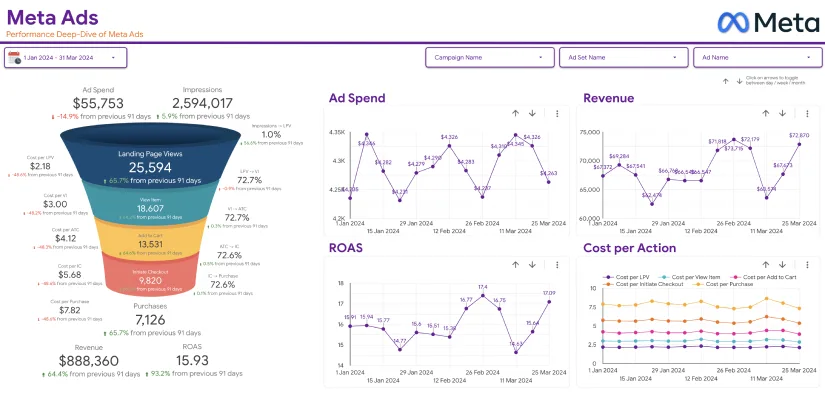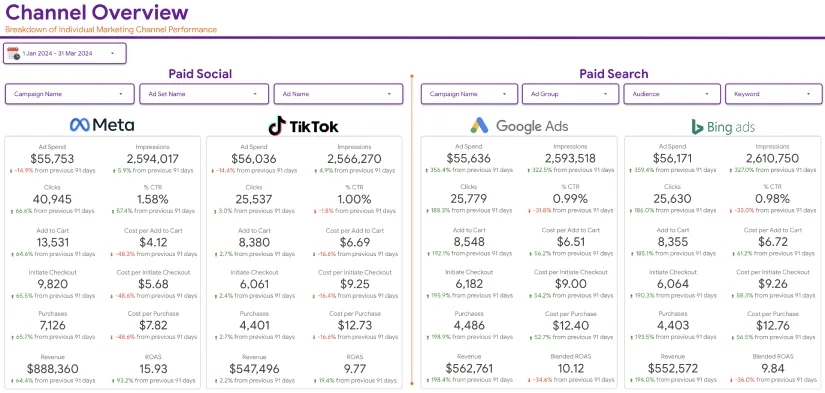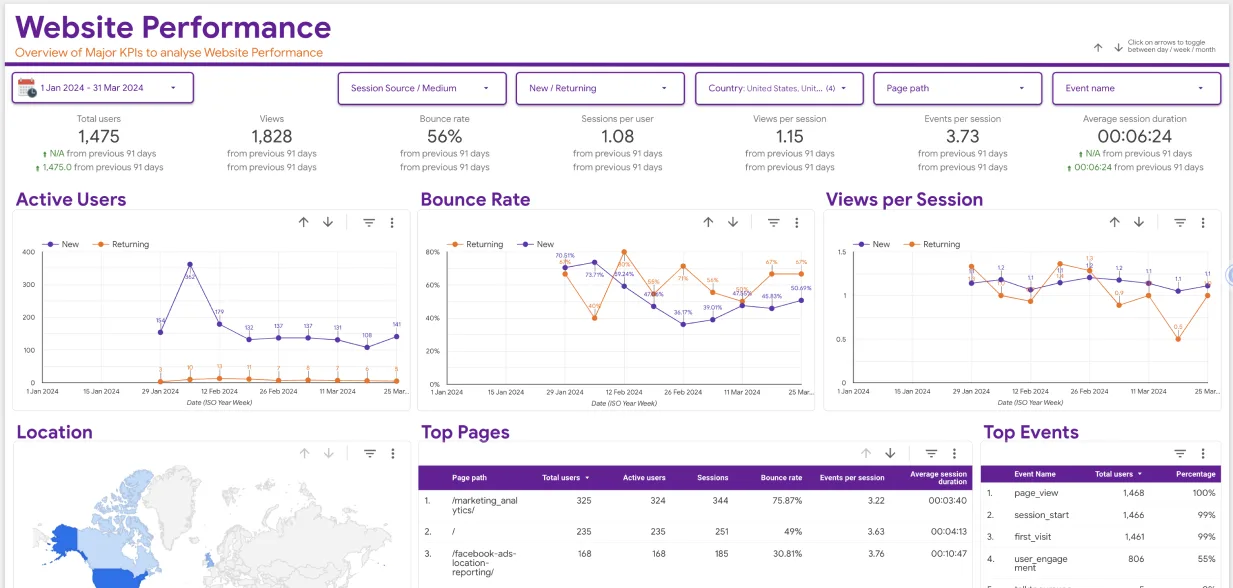The world of digital marketing is quite complex and to navigate it successfully, you can rely on real-life examples of marketing analytics as your guide to enhance your strategies. Marketing analytics utilizes raw data to track customer behavior and optimize user experience to boost conversions.
That’s what the big successful brands around the world have figured out and are leveraging to dominate the market. These businesses understand that every swipe, click, and interaction leaves a data trail that they can use to understand their customers. With the marketing analytics derived from the data, these companies are making informed decisions, optimizing their strategies, and boosting their ROI.
But let’s not focus too much on the theory. With real-life examples of how brands across different industries are using marketing analytics, you might get better insights into how to drive your business success. First, let’s try to understand what marketing analytics is.
What is Marketing Analytics?
Marketing is all about creating personalized experiences for your audience and customers. And the only way to do that is if you understand your target audience better. What are they into? What is their purchasing behavior? Marketing analytics uses data you’ve been collecting from your customers and audience to answer such questions.
So, marketing analytics is the process of collecting, measuring, and analyzing marketing data to identify what’s working and what isn’t in your marketing strategies. Whether it’s social media posts or email campaigns, marketing analytics goes deep into the data trails your audiences left behind. You can then derive actionable insights about their preferences, behaviors, and trends.
Why It Matters to Your Strategy
Marketing analytics is a complex time-consuming process with so many challenges that PPC managers and marketers have to deal with every day. Despite all these challenges, why do they keep doing it? Well, marketing without analytics is tantamount to flying blind. And let’s be honest about it, no organization is ready to implement a marketing strategy without understanding the direction they’re headed.
Understand your audience

One of the major reasons for renowned brands like Netflix or Starbucks doing marketing analytics is they can understand their clients to serve them better. In fact, this is what builds the foundation of any marketing campaign. Analyzing your marketing data helps you understand who your target audience is, what they need, and when they need it.
Make Predictions Supported By Data
The digital world is highly competitive and the first to act on an existing opportunity gets to rip the most. And the only way you can identify an opportunity is if you analyze the data you’re collecting. Marketing analytics helps you spot trends, patterns, and shifts so you can act fast before the opportunity window closes.
Optimize Your Outcomes
Once you understand your customers and market trends, you can start optimizing your outcomes to perform even better. By doing this, you eliminate room for guesswork on what your next strategy should be. Instead, you’ll be using what you discovered from your analytics to adjust your marketing campaigns and attend to your customers’ needs.
Prevent Recurrent Risks and Losses
Optimizing your marketing strategy helps you identify and close any potential risks and losses. These could be targets, strategies, channels, or other aspects of your campaign that are no longer bearing fruits, but instead costing you more money.
Tweak Your Strategy in Real Time
Another benefit of marketing analytics to your marketing campaign is the ability to make changes to your strategy in real time. For instance, if one of your emails is as popular as a bad dad joke, you’ll be able to tell why, thanks to analytics. It could be the subject or maybe because you sent it at 2 a.m. when your clients were dead asleep.
Top 8 Examples of Marketing Analytics from Global Brands
Analytics has evolved from a desirable to an obligatory requirement in any marketing strategy, and these eight examples of marketing analytics prove it. So, if you haven’t, you should be looking for strategies to make use of the data you’re collecting to set your business apart.
1. Netflix: Personalizing Customer Experiences

First on our list is Netflix, one of the top streaming services that seems to know what you’d like to watch. Netflix uses a powerful recommendation algorithm to show suggestions to viewers based on their watch history and searches. This is one of the best examples of marketing analytics in action.
Netflix collects tons of user behavior data which it analyzes. These include the shows you watch, the amount of time you spend watching, whether you binge-watch an entire season in one sitting, when you hit pause, and more. It’s amazing how Netflix can guess the type of content that’ll keep you hooked and renew your subscription. It’s all because of marketing analytics.
Key Metric and Takeaway
Netflix uses engagement data such as interaction frequencies, viewing patterns, and geolocation information to tailor its recommendations as well as plan for future productions.
From Netflix’s success, we learn that personalization is a major driver of customer loyalty. And marketing analytics is the foundation for delivering customized experiences.
2. Spotify: Data-Driven Playlists
If you think Spotify’s success is because of its massive music catalog, think again. Spotify’s secret lies in how it serves music to listeners. Through marketing analytics, they track how users interact with songs, artists, and playlists. It then uses the data to curate highly personalized playlists like “Release Radar” and “Discover Weekly.” And that’s how it keeps users engaged and exploring new content continuously. Also, the “Wrapped” feature gives listeners a preview of their habits on the platform.
Key Metric and Takeaway
Playlist interactions, listening habits, and user engagement data are important to Spotify’s marketing strategy. Through marketing analytics, Spotify has created a unique, personalized listening experience that keeps users glued to the platform for longer.
3. Amazon: Optimizing Pricing and Inventory
How Amazon utilizes data for its success is another excellent example of marketing analytics. What makes the e-commerce giant the king of the industry is not its vast inventory. It’s marketing analytics that drives every decision-making, from deciding pricing to the type of products showcased to shoppers.

Amazon analyzes real-time customer demands, market trends, competitor pricing, as well as historical data to ensure their product listings are competitively priced. By using a dynamic pricing model, they attract more customers to not only boost sales but also maintain a high customer satisfaction rate.
Key Metric and Takeaway
Amazon’s pricing engine relies heavily on analytics from customer demand forecasts, pricing data, and competitor analysis. From the example of Amazon, we can deduce that marketing analytics goes beyond understanding the customer. It’s about enhancing operational efficiency and knowing how to strike a balance between pricing and demand.
4. Coca-Cola: Understanding Customer Sentiment
Almost everywhere you go, you cannot miss a warm, enchanting ad from Coca-Cola. This simply tells you that Coca-Cola has mastered the art of brand awareness. Its strategy revolves around creating a strong brand image that reverberates with people of different cultures, ages, and backgrounds.
Coca-Cola goes beyond selling just a product; it focuses on forging strong emotional connections with people and creating a sense of belonging in its consumers. This strategy has been the driving force behind its dominant position in the industry for more than a century.
It leverages social media listening and powerful analytics tools to track conversations about the brand on different platforms. It then uses the data to measure customer satisfaction, identify potential problems, and spot emerging market trends.
Key Metric and Takeaway
Coca-Cola has managed to stay on top of the beverage industry for long because it relies on social media sentiment analysis, engagement data, and brand mentions to drive its success. From this, we learn that marketing analytics isn’t just about the numbers, but it’s about listening to your customers and responding to what they’re saying on time.
5. Nike: Enhancing Digital Marketing Campaigns
Nike makes a great inclusion into this list of examples of marketing analytics for its storytelling campaign strategy. The brand has built a successful apparel and footwear empire the world over by crafting compelling campaigns that resonate with its audience. This level of success has majorly been supported by marketing analytics.

This apparel brand has taken its marketing to a higher level by leveraging influencers to push its messaging. From Michael Jordan, Serena Williams, and Colin Kaepernick, to Cristiano Ronald, Nike is known for its tactic of using celebrities to connect with people, and it’s always worked. The day the Kaepernick ad was unveiled, Nike recorded a 31% sales surge.
Nike collects data from social media interactions, browsing behavior, and customer purchases to optimize their campaigns. This helps them know which ads are working, the influencers driving sales, and the messaging that their target audience identifies with.
Key Metric and Takeaway
Nike’s marketing strategies heavily rely on campaign performance data, influencer impact analysis, and customer purchase trends.
Through marketing analytics, you can fine-tune your messaging to make it relevant and impactful to your audience across every channel.
6. Starbucks: Crafting Loyalty Programs
Ever wondered why Starbucks is so serious about its loyalty reward program? Because that’s where 55% of their sales came from in 2022 and is still their biggest revenue driver. The coffee giant leverages marketing analytics to monitor their customers’ behavior, understand their orders, when and where orders are placed, et cetera.
By analyzing this data, Starbucks offers personalized promotions and rewards that keep customers coming back. They also utilize customer location data to optimize their store placement and inventory. This helps in ensuring customers never miss their morning latte.
Key Metric and Takeaway
Starbucks fuels its personalized offers by leveraging analysis of customer purchase history, mobile app engagement data, and loyalty card usage.
The important takeaway from Starbucks’ example is that crafting brand loyalty is about understanding your customers’ habits and rewarding them in the best ways they can appreciate.
Conclusion: Marketing Analytics – The Future of Strategy
From these real-life examples of marketing analytics in action across different industries, we can see that analytics is no longer a nice-to-have element of successful business strategy. It’s now a must-have solution if you want your brand to remain relevant in the market. It can help your business make more informed marketing decisions and optimize your ROI.
Are you ready to unleash the power of marketing analytics for your business? Let Eaglytics Co. help you with data-driven insights to elevate your marketing efforts. Get in touch with us today to get you started on your journey to brand success with marketing analytics.





